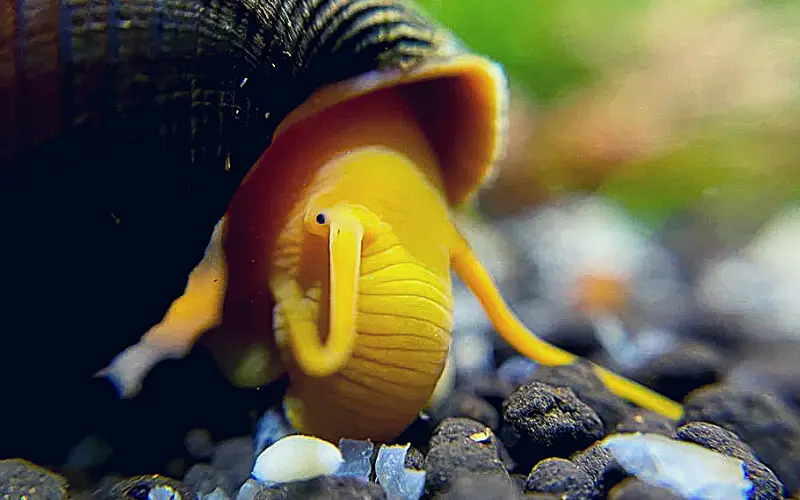The aquarium hobby is full of unique and fascinating creatures, but have you ever considered the humble rabbit snail? These little mollusks, with their adorable bunny ear-like tentacles, are more than just cute faces. But do rabbit snails burrow?
The answer is a resounding yes! And this intriguing behavior is just one of the many reasons why rabbit snails are a must-have for your freshwater tank.
From their algae-eating prowess to their peaceful personalities, discover why these burrowing beauties deserve a spot in your underwater world.

Rabbit snails, known as Tylomelania, are fascinating creatures that have become increasingly popular among aquarium enthusiasts.
One common question that arises when it comes to these unique snails is whether or not they burrow. In this article, we will explore the behavior of golden rabbit snails and why you should consider adding them to your aquarium.
Rabbit snails are known for their distinctive appearance, with their large, rabbit-like faces and elongated bodies. They are freshwater snails from Southeast Asia, often found in slow-moving rivers, lakes of Sulawesi Indonesia, and streams.
While elephant snails are not known for burrowing like some other species, they exhibit interesting behavior in the aquarium environment. So why should you consider adding rabbit snails to your planted tank?
Stay tuned as we uncover the top five reasons why these unique creatures can be a valuable addition to your aquatic collection.
Table of Contents
ToggleDo Rabbit Snails Burrow?
Yes, rabbit snails are known for burrowing in the substrate of their aquarium. They have long snouts that help them dig through the sand or gravel for food. They prefer a fine substrate like sand or smooth, round aquarium soil because it’s easier for them to burrow through.
Sharp gravel can injure their bodies. Their burrowing helps to aerate the substrate and keep it healthy for the tank’s ecosystem.
Importance of Understanding Rabbit Snails’ Burrowing Behavior
Knowing that healthy populations of these snails exist at different depths can aid in deciphering muddled biotope data in the future.
Depth is often a limiting factor for aquarists looking to replicate a biotope that needs certain species that may only be found at a specific depth. Tylomelania could undoubtedly be found at all levels in the few places where they are discovered.

He said, “These snails are most active at night, traveling on stream bottoms and climbing about in the marginal areas. They will consume detritus, algae, and other organic matter growing on submerged wood or rocks, but their preference is definitely the areas abounding in vegetation.”
“Tylomelania are enigmatic snails often found in fast-flowing streams, particularly in the riffles that provide a border between quick and slow water,” said Matt Ford in his article on these interesting mollusks.
Understanding the burrowing behavior of Tylomelania (T.) sp., also known as elephant snails, is essential for several reasons.
Unlike the handful of other genera that comprise the majority of snails seen in the aquarium hobby, Tylomelania is obligate (or nearly so) amphibious gastropods; they spend very little time wholly submerged in water, preferring to explore and forage in the riparian zone or areas where water and land mix.
5 Reasons Why You NEED Rabbit Snails!
Rabbit snails can be a great addition to a freshwater aquarium, but needing them might be vital. Here are some reasons why you might want one, though:
- Cleaning Crew: Rabbit snails are algae eaters and detritivores, meaning they munch on leftover food and decaying plant matter. This helps keep your tank clean and reduces the amount of maintenance you need to do.
- Waste Not, Want Not: Rabbit snail poop is beneficial for your tank. It serves as a fertilizer for live plants and a food source for some fish and shrimp.
- Variety is the Spice of Life: Rabbit snails tylomelania come in a surprising array of colors and patterns, adding a touch of visual interest to your aquarium.
- Peaceful Coexistence: These guys are peaceful herbivores and won’t bother your fish or other tank mates.
- Live Entertainment: Yellow rabbit snails are fascinating to watch as they glide around your tank, constantly on the munch.
Do Rabbit Snails Burrow Like MTS?
The answer depends on what you mean by “burrow.” While both burrow, there’s a key difference: Rabbit snails dig shallowly for food and egg-laying, while Malaysian Trumpet Snails (MTS) burrow deeply and constantly, creating extensive tunnels.
- Digging into the substrate: Like many other aquarium snails, Rabbit snails will dig into the substrate to find food or lay eggs. This might involve burying themselves wholly or partially. So, in this sense, they do exhibit burrowing behavior.
- Creating permanent burrows: Unlike some animals that make complex tunnel systems, golden rabbit snails don’t build permanent burrows. Their digging is usually temporary and focused on specific tasks like feeding or egg-laying.
Here’s some additional fully formed information about rabbit snail behavior that relates to the substrate:
- Substrate preference: Rabbit snails prefer a soft, sandy substrate that allows them to dig easily. Avoid using gravel or sharp substrates, which can damage their delicate bodies.
- Activity level: Rabbit snails are generally more active at night and might be seen digging and exploring the substrate.
- Benefits of digging: Digging helps aerate the substrate, benefiting plants and other aquarium organisms.
I hope this information helps! Let me know if you have questions about rabbit snails or other aquatic creatures.
Rabbit Snails vs. Malaysian Trumpet Snails (MTS) – A Burrowing Battle: While both rabbit snails and Malaysian trumpet snails (MTS) exhibit burrowing behaviors, there are some key differences:
Rabbit Snails:
- Digging depth: They usually dig just below the surface, partially or fully burying themselves.
- Purpose: Primarily for foraging food and laying eggs.
- Frequency: Occasional digging, mainly during their active periods (usually at night).
Malaysian Trumpet Snails (MTS):
- Digging depth: They are known to burrow Pretty much deeper into the substrate, creating extensive tunnels.
- Purpose: Primarily for finding food and avoiding predators.
- Frequency: They spend most of their time buried, constantly moving through the substrate.
Here’s a table summarizing the key differences:
Feature Rabbit Snail Malaysian Trumpet Snail (MTS) Digging Depth Shallow Deep Primary Purpose Food, Eggs Food, Avoiding Predators Frequency Occasional Constant Impact on the Aquarium:
- Rabbit snails: Their digging activity is generally beneficial as it helps aerate the substrate.
- MTS: While their burrowing can also help with aeration, a large population can cause issues by constantly disturbing plant roots and creating cloudy water.
Overall, rabbit snails are much less intensive burrowers compared to MTS. They spend significant time above the substrate, and their digging is more sporadic and less disruptive to the aquarium environment.
How Do Rabbit Snails Sleep?
Like many other aquatic snails, rabbit snails don’t sleep the same way humans or other mammals do. They don’t have eyelids, so they can’t close their eyes, and they don’t experience the same kind of sleep-wake cycle.
However, they have periods of inactivity where their metabolism slows down and become less responsive to their environment. This can be considered a form of “sleep” or rest.
Here’s what we know about rabbit snail rest:
- Reduced activity: During their resting periods, rabbit snails will often remain stationary, attached to a surface like an aquarium glass, a plant, or decoration.
- Antennae withdrawal: They might retract their antennae partially or entirely, which is a sign of relaxation and decreased alertness.
- Respiration changes: Their breathing rate might slow down during rest periods.
Factors Influencing Rest:
- Light levels: Rabbit snails are more active at night and tend to rest during the day when light levels are higher.
- Food availability: After feeding, they might rest to digest their food.
- Water conditions: Stable and comfortable water parameters contribute to well-being and healthy rest patterns.
Observing Rest:
It can be challenging to tell whether a rabbit snail is “sleeping” or just resting. However, observing their activity level, antennae movement, and general behavior can give you a sense of their rest patterns.
Commonly Asked Questions about Rabbit Snails Burrowing Skills (FAQs)
What size tank does a snail need?
The ideal tank size for a snail depends on the species. As a rule, aim for at least 5 gallons with 1 gallon per additional snail. This ensures enough space and helps maintain good water quality.
Is my snail sleeping or dead?
What do snails look like when they sleep? Telling a sleeping snail from a dead one can be tricky. Check for a bad smell, a floppy foot, or an open shell. If none of those, your snail is likely just catching some Zzzzzzzz.
Will rabbit snails overpopulate?
Golden rabbit snails are unlikely to overpopulate. They lay clutches with few eggs, and offspring survival can be low in aquariums.
Is my snail dead if it isn’t moving?
Not necessarily! Snails can stay still for long periods. Check for other signs of life, like a retracted body or a foul smell.
Do dead snails sink or float?
Dead snails typically float due to decomposition gases accumulating inside their cone shaped shells. However, a floating snail doesn’t necessarily mean it’s dead.
Do rabbit snails get along with Mystery snails?
Not ideal. Rabbit snails are predatory and can eat Mystery snails, especially in smaller tank sizes with limited food. Consider Nerite snails as peaceful tankmates for Rabbit snails.
Do rabbit snails grow?
Yes, rabbit snails can grow! They are a larger freshwater snail species reaching up to 3 inches in length.
How big are chocolate rabbit snails?
Chocolate rabbit snails pack a punch in the size department! These guys can grow up to 4 inches long, making them one of the bigger freshwater snails for your aquarium.
What temperature do rabbit snails like?
Rabbit snails prefer warm water temperatures, between 76 and 84 degrees Fahrenheit (24-28°C). They can tolerate a broader range, but cooler temperatures may make them less active.
Can you feed snails algae wafers?
Yes, algae wafers can be a supplemental food for snails. While not all snails prioritize them, many enjoy the algae and other nutrients they provide. However, a varied diet with blanched veggies and calcium sources is ideal for snail health.
Will rabbit snails reproduce?
Yes, rabbit snails reproduce sexually with males and females. They give birth to live baby snails, one or two at a time, in a white egg sack every 4-6 weeks.
Are rabbit snails easy to breed?
Breeding rabbit snails can be challenging. While not impossible, breeding rabbit snails successfully requires specific conditions and patience.
Conclusion
Adding elephant snails to your aquarium brings many benefits beyond their adorable appearance. They’re peaceful tank mates and algae-eating champions, and their gentle burrowing habits contribute to a healthy substrate. Whether you’re a seasoned aquarist or just starting your underwater journey, consider welcoming these fascinating creatures into your aquatic world. You’ll be amazed by their positive impact on your tank’s ecosystem and the joy they bring as you observe their intriguing behaviors, including their occasional digging adventures. So, if you’ve ever wondered, “do rabbit snails burrow?” The answer is a resounding yes, and it’s just one of the many reasons you need these shelled wonders in your aquarium!
Recommended Posts
- Top 7 Exotic Types of Rabbit Snails (That Will Amaze You!)
- Rabbit Snail Temperature 101: A Comprehensive Care Guide
- Baby Rabbit Snail: 5 Ways to Avoid Disaster! (Expert Tips)
- Do Rabbit Snails Eat Plants in Aquarium: (Experts Advice)
- How Big Do Rabbit Snails Get in a Tank: (Quick Facts!)
- Are Rabbit Snails Asexual: 3 Easy Ways to Breed Them!
- What Do You Feed Rabbit Snails: (7 POWER Foods They LOVE!)
- How Many Rabbit Snails Per Gallon Tank: 2 EASY Steps for Success!
- Will Rabbit Snails Eat Other Snails: (1 Shocking Truth!)
- Do Rabbit Snails Hibernate: (Secret Winter Survival Trick!)





